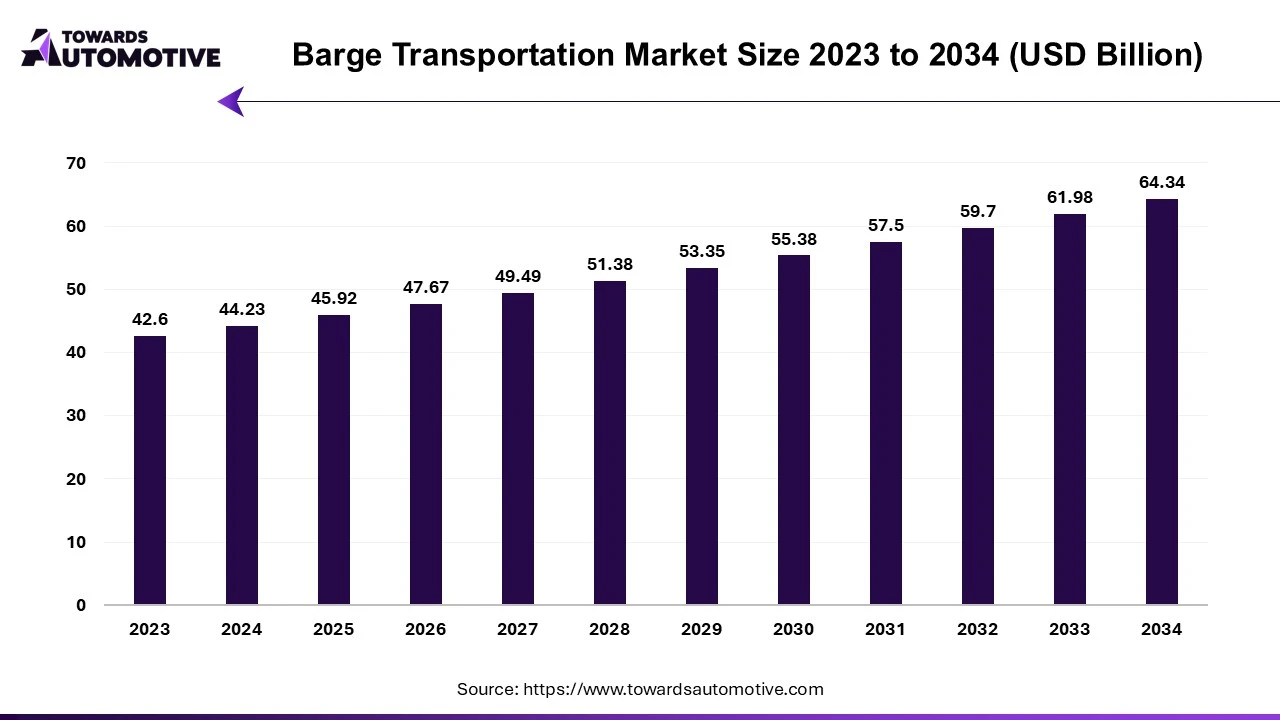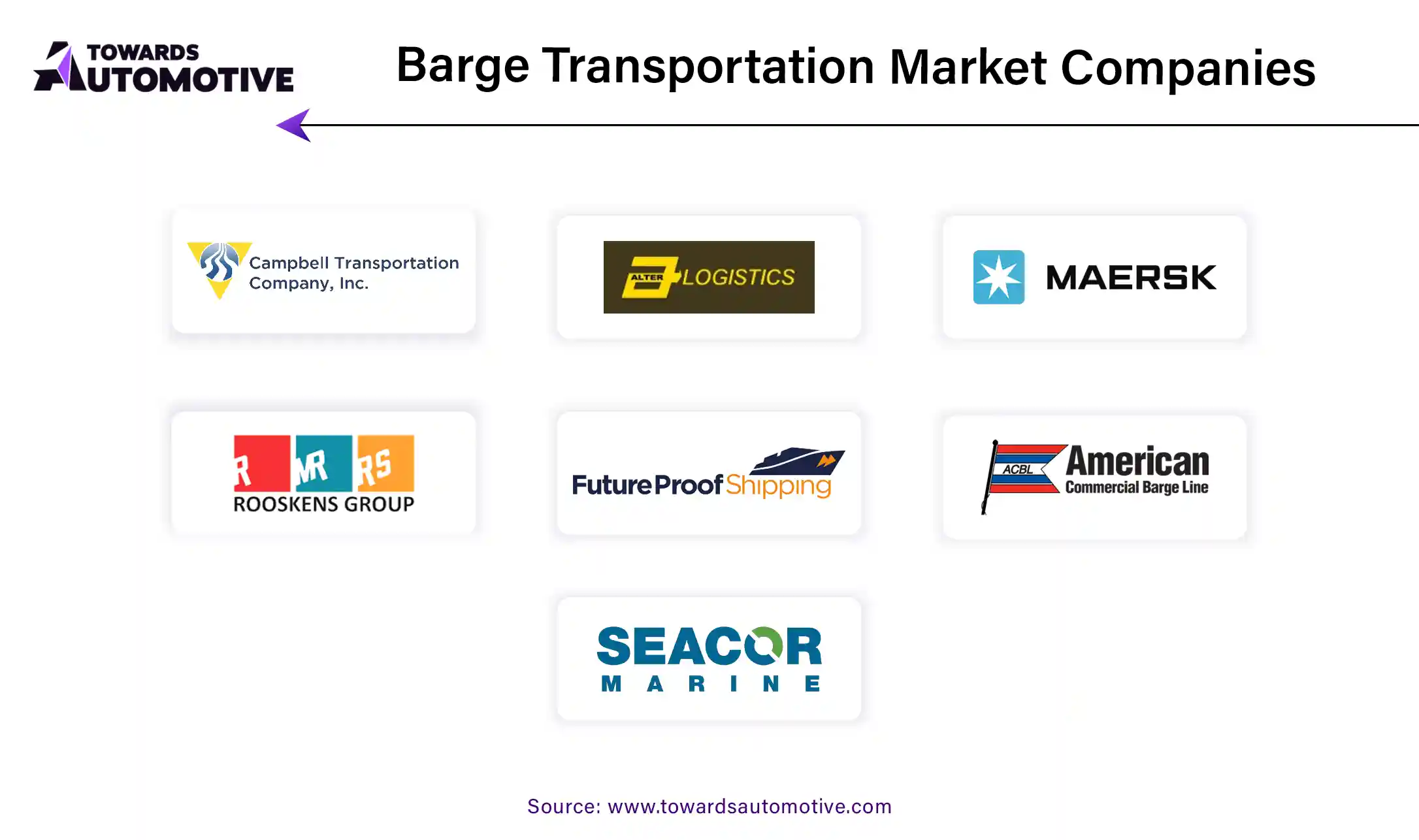April 2025
The barge transportation market is projected to reach USD 64.34 billion by 2034, growing from USD 45.92 billion in 2025, at a CAGR of 3.82% during the forecast period from 2025 to 2034.

Unlock Infinite Advantages: Subscribe to Annual Membership
The barge transportation market plays a vital role in global logistics, offering an efficient and cost-effective solution for moving bulk commodities and heavy cargo over inland waterways. This mode of transportation is particularly crucial for industries such as agriculture, mining, construction, and energy, as it supports the shipment of goods like grains, coal, chemicals, petroleum products, and raw materials. Barge transportation provides several advantages, including lower fuel consumption, reduced carbon emissions, and the ability to move large volumes of cargo in a single trip, making it an eco-friendly and economical alternative to rail and road transportation.
The market is experiencing steady growth due to increasing trade activities, rising investments in waterway infrastructure, and advancements in barge design and fleet modernization. Additionally, government initiatives aimed at promoting inland waterways as a sustainable transportation mode are driving the market’s expansion. The integration of digital technologies, such as GPS tracking, automated navigation systems, and fleet management tools, is further enhancing the efficiency and reliability of barge operations.
As global trade volumes continue to rise and the emphasis on sustainable logistics intensifies, the barge transportation market is poised for significant growth, playing an indispensable role in supporting global supply chains and reducing the environmental impact of freight transportation.
Artificial Intelligence (AI) is playing an increasingly important role in the barge transportation market by enhancing operational efficiency, improving safety, and optimizing logistics. One of the key areas where AI is making an impact is in fleet management. AI-powered systems can analyze data from sensors and GPS to track barge locations, monitor fuel consumption, and predict maintenance needs. By leveraging predictive analytics, AI helps operators reduce downtime by identifying potential equipment failures before they occur, ensuring that barges remain operational and reducing repair costs.
AI also plays a crucial role in route optimization. By considering factors like waterway traffic, weather conditions, and tide patterns, AI can recommend the most efficient routes for barges, reducing fuel consumption and transit times. This enhances cost-effectiveness and improves delivery schedules, crucial for time-sensitive shipments like perishable goods.
Additionally, AI is contributing to the automation of navigation systems. With advancements in autonomous vessel technologies, AI can assist in the navigation and control of barges, reducing the need for human intervention, and enhancing safety on waterways by minimizing the risk of human error.
The rising use of internal waterways for domestic trade is a significant driver of growth in the barge transportation market. As countries increasingly recognize the economic and environmental benefits of waterborne transportation, there has been a marked shift toward utilizing inland waterways for the movement of goods. Barges are particularly well-suited for transporting bulk commodities such as coal, agricultural products, and petroleum over long distances. In regions with established river networks, such as North America and Europe, the growing reliance on inland waterways for domestic trade helps alleviate congestion on roads and railways, reducing the strain on overburdened transportation infrastructure.
In addition, the cost-effectiveness of using internal waterways for domestic trade further drives the demand for barge transportation. Barges offer a lower cost per ton of cargo compared to other transportation modes, especially for large volumes of non-perishable goods. This makes barge transport an attractive option for industries looking to minimize logistics costs while ensuring timely delivery.
Moreover, the increasing focus on sustainability and reducing carbon emissions is pushing more industries toward waterborne transport. Internal waterways offer an eco-friendly alternative to road and rail, contributing to greener, more sustainable domestic trade solutions. The combination of economic, environmental, and logistical benefits has made the rising use of internal waterways a key factor in the growth of the barge transportation market.
The barge transportation market faces several restraints, including limited geographical coverage, as barges are only viable on navigable rivers, canals, and coastal routes. Infrastructure constraints, such as outdated ports and inadequate terminal facilities, can hinder efficiency and increase operational costs. Additionally, weather conditions, such as droughts or flooding, can disrupt barge schedules and affect cargo delivery. Regulatory challenges, including environmental restrictions and safety standards, may also add complexity and increase operational costs, further limiting market growth.
Technological innovation plays a crucial role in creating opportunities within the barge transportation market, significantly improving efficiency, safety, and sustainability. Advanced navigation technologies, such as GPS tracking and automated systems, allow for more precise and efficient route planning, reducing fuel consumption and transit time. Real-time tracking provides stakeholders with up-to-date information on cargo status, enabling better inventory management and timely deliveries. Furthermore, the adoption of automation in operations, including automated cargo handling and remote-controlled vessels, reduces labor costs and enhances operational efficiency.
Sustainability is another area where technological advancements offer significant opportunities. With increasing pressure to reduce emissions, barge operators are turning to more eco-friendly solutions. Innovations such as energy-efficient engines, hybrid propulsion systems, and the use of renewable fuels, such as biofuels, help minimize the environmental impact of barge transport. These advancements also help companies comply with stricter environmental regulations while appealing to environmentally conscious consumers and businesses.
Digital technologies, such as predictive maintenance and big data analytics, also improve the performance of barges by minimizing downtime and reducing operational costs. Predictive maintenance tools use sensors and data to monitor the health of critical components, ensuring timely repairs and extending the lifespan of vessels. Additionally, digital platforms enhance communication and coordination between barge operators, freight forwarders, and customers, streamlining supply chains and improving overall service levels. As technology continues to evolve, the barge transportation market will see greater efficiencies, reduced costs, and enhanced capabilities, creating further opportunities for growth and development.
The dry cargo segment held a dominant share of the market. The dry cargo segment plays a pivotal role in driving the growth of the barge transportation market, as it encompasses the transportation of a wide range of bulk goods, including coal, grains, iron ore, cement, and other non-perishable materials. Barge transportation is particularly suited for dry cargo due to its ability to carry large volumes of goods over long distances at a lower cost compared to other modes of transport. This is especially beneficial for industries such as agriculture, mining, and construction, where the movement of bulk commodities is essential to supply chains.
As global trade continues to expand, the demand for dry cargo transportation is increasing, boosting the need for efficient barge services. Inland waterways, which are more cost-effective and environmentally friendly compared to road or rail transport, are becoming increasingly utilized for the shipment of dry bulk goods. The dry cargo segment is also benefiting from the rising need for sustainable transportation solutions, as barges generate fewer emissions per ton of cargo compared to trucks and trains.
Technological advancements in cargo handling, such as automated loading and unloading systems, further enhance the efficiency of dry cargo transportation. As a result, the dry cargo segment remains a key driver of growth in the barge transportation market, contributing significantly to the movement of essential bulk materials across global supply chains.
The crude & petroleum products segment led the industry. The crude and petroleum products segment is a significant driver of growth in the barge transportation market, as barges provide an efficient and cost-effective means of transporting these essential commodities. Oil and gas producers rely on barge transport to move crude oil, refined petroleum products, and other chemicals across inland waterways, where infrastructure like pipelines may not be readily available. The flexibility of barges, which can navigate rivers, canals, and coastal routes, allows for the seamless transportation of petroleum products to refineries, storage terminals, and distribution hubs.
As global demand for energy continues to rise, the need for transportation of crude and petroleum products has expanded, particularly in regions with extensive river networks such as North America and Europe. Barge transportation is especially attractive for large volumes of bulk shipments due to its lower cost and environmental benefits compared to road and rail transport. Additionally, barges offer the ability to carry a wide variety of petroleum-related products, including gasoline, diesel, and liquefied petroleum gas (LPG), making it an essential mode of transportation for the energy sector.
The increasing focus on sustainability within the energy industry also contributes to the growth of this segment, as barges offers eco-friendly alternatives than other transportation modes. As the demand for crude and petroleum products continues to rise, the crude and petroleum products segment will remain a key factor in the expansion of the barge transportation market.
Europe dominated the barge transportation market. Sustainability and environmental concerns, the efficient inland waterway network, and infrastructure investments are key drivers of the barge transportation market in Europe. As the European Union intensifies its focus on reducing carbon emissions and promoting sustainable practices, barge transportation is increasingly favored due to its eco-friendly nature. Barges generate significantly lower emissions per ton of cargo compared to road and rail transport, making them a vital part of Europe’s green logistics strategy. Additionally, Europe’s extensive and efficient inland waterway network, including the Rhine, Danube, and the Seine, provides an optimal infrastructure for the bulk movement of goods, such as coal, agricultural products, and petroleum. These waterways offer a cost-effective and energy-efficient alternative to land-based transportation, contributing to the growing demand for barge services.
Moreover, ongoing investments in the modernization and expansion of inland waterway infrastructure are further fueling market growth. European governments and private entities are investing in enhancing port facilities, locks, and navigational systems, improving operational efficiency and reducing bottlenecks. These infrastructure upgrades not only make barge transport more reliable and efficient but also increase capacity to meet the rising demand for bulk goods transportation. Collectively, sustainability goals, a robust inland waterway network, and infrastructure advancements are driving the barge transportation market’s growth across Europe.
North America is expected to grow with the highest CAGR during the forecast period. The growth in the energy and commodities sectors, multimodal integration, and cost-effectiveness are crucial drivers of the barge transportation market in North America. The energy sector, particularly the demand for crude oil, natural gas, and refined petroleum products, relies heavily on barge transportation for moving large quantities of these goods along rivers and coastal routes. Barge transport offers an economical solution for these bulk commodities, making it a preferred choice for industries involved in energy production and distribution. As the energy sector continues to expand, so does the need for reliable and cost-effective transportation options.
In addition, the growing trend of multimodal integration plays a significant role in the barge transportation market’s growth. By linking barges with rail and road transportation systems, businesses can create more flexible and efficient logistics solutions, enabling seamless and cost-effective movement of goods across North America. This integration optimizes supply chains, reduces delays, and lowers transportation costs, making barge transport even more attractive.
The cost-effectiveness of barge transportation further enhances its growth potential. Barges can carry large volumes of goods at lower operating costs compared to other modes, such as trucks and trains. This cost advantage, coupled with the increasing demand for bulk commodity transport, positions the barge transportation market as a key component of North America's logistics infrastructure.

By Type
By Barge Fleet
By Application
By Barge Activities
By Region
April 2025
April 2025
April 2025
April 2025
We offer automotive expertise for market projections and customizable research, adaptable to diverse strategic approaches.
Contact Us